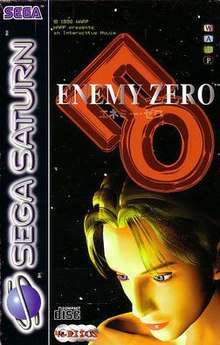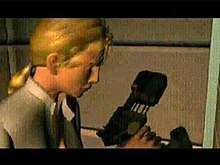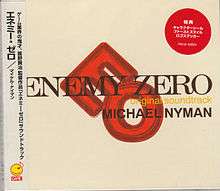Enemy Zero
Enemy Zero[2] is a 1996 survival horror adventure video game for the Sega Saturn, developed by Warp and directed by Kenji Eno. After its Saturn release, it was ported to Microsoft Windows. It was the second game to star the "digital actress" Laura, the first being D, and the third being D2. Laura is voiced by Jill Cunniff of the band Luscious Jackson in the English versions and Yui Komazuka in the Japanese version.[3]
| Enemy Zero | |
|---|---|
 European Sega Saturn cover art | |
| Developer(s) | Warp |
| Publisher(s) | Sega
|
| Designer(s) | Kenji Eno |
| Writer(s) | Yūji Sakamoto |
| Composer(s) | Michael Nyman |
| Platform(s) | Sega Saturn, Microsoft Windows |
| Release | Sega SaturnWindows |
| Genre(s) | Survival horror, interactive movie, adventure |
| Mode(s) | Single player |
Gameplay

In Enemy Zero, gameplay sequences alternate between interactive full motion video (FMV) and real time exploration, both from a first person perspective. The interactive FMV component uses gameplay identical to an earlier Warp game, D.[4]
The real time component of Enemy Zero is unique. Enemies are invisible, and location is only possible through the use of sound, with notes of different pitch helping the player find the distance and direction of enemies.[5] Additionally, every gun in the game must be charged up immediately before each shot, and charging a shot for too long will cause the charge to dissipate, after which the charging must start over. Since all available guns have very limited range, this makes timing crucial; beginning to charge the gun too late or too soon will allow the enemy to reach Laura, resulting in an immediate game over. Reloading the gun and moving the character around are mechanics that have been made intentionally slow,[6] which stimulates players to avoid combat and direct contact with the alien enemies as much as possible. In the early segments of the game, avoiding detection is not only recommended; it is required, since the player has no means to defend themselves without a gun.
Plot
Aboard the AKI space craft, a space station dedicated to biological research, Laura Lewis is in a deep cryogenic slumber. The jets of the chamber dissipate as the craft's emergency systems are activated. Laura is awakened by a large detonation on her deck. Outside a door marked with the letters E0, something of great strength is trying to break free. The door is thrown down, and the hallway is filled with a bright, incandescent light, followed by a horrific growl. Pipes and the remains of the steel door shift around, as if being stepped on. Laura, unaware of what is happening, uses the video phone above her sleep chamber to contact one of her crewmates, Parker. Laura watches in confusion as Parker looks away from the monitor, to his room's entryway doors. A screech sends him backing up to reach for his gun. Laura watches as Parker is mutilated by an unseen enemy.
Getting dressed and grabbing her gun, Laura heads out to learn what attacked Parker. As she ventures through the ship, Laura's earring-shaped "guidance system" gives her aural warnings of invisible enemies (seen escaping in the intro sequence) roaming the ship's corridors. Laura meets up with Kimberley, another crewmate, and they make a plan to rendezvous with the other survivors. On their way Kimberley is attacked by an enemy and disappears, forcing Laura to make the journey on her own. She meets up with George, the ship's resident computer scientist, as well as David, her lover, and together they plan to head for the escape shuttles. Exploring the deceased captain's study, Laura discovers a log file that reveals that goal of the mission is to capture the enemies and bring them back to Earth for use as biological weapons on behalf of Vexx Industries, and that the crew is expendable in case of an accident.
David is attacked by one of the enemies, and when Laura discovers his corpse, she learns that David was actually an android. She performs a body-scan on herself, and finds that not only is she also an android herself, but that one of the enemy larvae is developing in her neck. George confronts her and tries to wipe her memories, but is attacked and killed by an enemy. When Laura heads for the escape pods, she finds Kimberley again, who kills the larva nesting inside of Laura, and reveals that she and Parker were assigned by Vexx Industries to supervise the mission. Kimberley then triggers the ship's self-destruct mechanism, and leaves Laura to join Parker, killing herself while cradled up next to his corpse. As Laura heads for the escape shuttle, her guidance system runs out of battery, but instead she receives guidance from David, whose consciousness has been uploaded to the ship's computer systems. Laura reaches the escape shuttle just in time as the AKI blows up behind her, and she enters cryogenic sleep one more time as she makes the return voyage to Earth.
Development
Enemy Zero began life on Sony's PlayStation. Its unveiling at the 1996 PlayStation Expo in Tokyo was described by journalists as the highlight of the show.[7] Irritated by Sony's failure to meet even a third of preorders for the PlayStation version of D (and to a lesser extent, their policy that all marketing for third party games had to be approved by them[4]), at a press conference during the expo Kenji Eno made a shocking move. Eno showed a preview of Enemy Zero. At the end of the clip the PlayStation logo appeared, but slowly transitioned into the Sega Saturn logo, indicating that the game would now be a Saturn exclusive.[8][9] Despite popular opinion that the Saturn cannot handle 3D games as well as the PlayStation, Eno commented "...the PlayStation and the Saturn aren't that different, so moving it [Enemy Zero] to Saturn wasn't too difficult."[8] Fumito Ueda, director of the cult video games Ico and Shadow of the Colossus, worked as an animator on this game, before becoming a video game director.[10] The game was in development for nine months.[10]
The full motion video sequences were all rendered on Silicon Graphics workstations using PowerAnimator.[11]
While Eno did the music for D, Michael Nyman, composer for films such as Gattaca and The Piano, was hired to create a score for this Warp title. In an interview, Kenji Eno explained how this came about:
...I like Michael Nyman a lot, and I like his soundtracks, so I was thinking that it would be awesome if I could get him to do the music. I thought, "That would be impossible, but it'd be great if that happened." ...then, there was a big earthquake in Kobe, Japan in 1995, and Michael Nyman was donating pianos to schools in the city. When this earthquake happened, he said that he wanted to check out how the pianos that he donated were doing, so he came to Japan. When I found out that he was in Japan, I invited him back to my hotel room and tried to convince him, for six hours, to come work with me. So, at the end, Michael was like, "OK, I'll do it, I'll do it. Just let me go back to my room." So he went back exhausted after being convinced for six hours. We didn't work out terms or conditions; he just said that he would do it.[8]
Eno had initially considered asking Ryuichi Sakamoto to create the score, but decided that his style would not be appropriate for the game.[12]
Music
| Enemy Zero | ||||
|---|---|---|---|---|
 | ||||
| Soundtrack album by | ||||
| Released | April 18, 1997 | |||
| Recorded | August 19, 1996, CTS Studio, London September 28-30, Abby [sic] Road Studio | |||
| Genre | Soundtrack, Contemporary classical, minimalism | |||
| Length | 49:54 | |||
| Label | First Smile | |||
| Producer | Michael Nyman, Kenji Eno | |||
| Michael Nyman chronology | ||||
| ||||
| Singles from Enemy Zero | ||||
| ||||
The music was performed by the Michael Nyman Orchestra and [[Sarah Leonard (singer)|Sarah Leonold [sic]]]. "Confusion" is a modification of material from Nyman's previous score, The Ogre, while the Enemy Zero/Invisible Enemy/Battle theme were modified into portions of Nyman's score for Man with a Movie Camera.[13] The main theme is a variation on "Bird Anthem" from Michael Nyman.
"Laura's Theme," "Digital Tragedy," and "Love Theme" are solo piano works and are included on the EP, Enemy Zero Piano Sketches, which was released eight months before the complete soundtrack, and two months before the game.
- Laura's Theme 4:01
- Confusion 3:45
- Aspects of Love 3:52
- Digital Tragedy 2:43
- Enemy Zero 4:20
- Lamentation 3:35
- Love Theme 3:42
- Digital Complex 2:48
- Invisible Enemy 2:13
- Laura's Dream 4:03
- Agony 3:16
- Malfunction 4:02
- Battle 3:48
- The Last Movement 3:44
Release
Released and received with much hype in Japan at the end of 1996, E0 was released in North America and Europe in 1997 under Sega. It was later ported to the PC by Sega.[14]
20 copies of a limited edition of the Saturn version were produced and sold for a price roughly equal to 2,000 US dollars. These special copies were hand-delivered to recipients by Kenji Eno himself.[8][15] The game thus holds the record for the "Most Exclusive Special Edition" of a video game, according to the 2012 Guinness World Records Gamer's Edition.[16] Due to popularity in Japan, Sega sponsored the production of a few Enemy Zero items such as the official Enemy Zero soundtrack by Michael Nyman, a model of the in-game gun, and a strategy guide.
Reception
| Reception | ||||||||||||||||||||||||||
|---|---|---|---|---|---|---|---|---|---|---|---|---|---|---|---|---|---|---|---|---|---|---|---|---|---|---|
| ||||||||||||||||||||||||||
Prior to Enemy Zero's release, John Ricciardi made it his pick for "Sleeper Hit of the Holidays", commenting that "I've yet to play an English version of the game (fortunately the Japanese one isn't too dependent on text), but I'm happy with what I've played of the import and I was a big fan of D."[26]
Enemy Zero received favorable reviews from several publications. Edge highly praised the first of the game's three discs for offering a "suspense-ridden atmosphere" and tense encounters with invisible aliens, comparing it favorably to Ridley Scott's cult classics Alien and Blade Runner. However, the magazine criticized the other discs for ruining that suspense with "space soap" themes and an almost embarrassing plot.[18] Electric Playground concluded that Enemy Zero "is definately [sic] one of the best Saturn games" of the year and its "high points are the innovations, like the energy gun and the VPS, that make playing this game unlike playing any other."[21]
Next Generation reviewed the Saturn version of the game, rating it four stars out of four, and stated that "Not only is Enemy Zero a fine adventure, but it also manages to advance the graphic adventure by emphasizing other senses besides pure sight. It may still have some of the faults of FMV-plagued games, but those problems dwindle to nothing compared to the overall experience."[19]
Ulrich Steppberger of Maniac Games scored it just 37 out of 100, saying that although the game replicates the ambiance of the film Alien, it has many problems that weigh the game down. He says the game has problems typical of FMV games such as trudging through long barren corridors and solving puzzles. He also said the weapon was unwieldy and hard to use, the ping system to find the enemy is not useful, while saying the FMV were high quality.[23]
In 1997, French magazine Consoles + scored it 89% overall, including individual ratings of 90% for presentation, 91% for graphics, 83% animation, 87% music, 82% sound effects, 90% lastability, and 90% playability. They concluded that, while it might not please everyone, it is a "gory, original and beautiful" adventure game with "high difficulty" and a "special atmosphere".[20] British magazine Mean Machines scored it 90% overall, including individual ratings of 91% for graphics, 89% for sound, 85% playability, and 69% lastability.[22]
American magazine GameFan awarded the game the Megaward for Best Import Game of the Year, for the year 1996.[27]
References
- Gentry, Perry (October 30, 1998). "What's in Stores Next Week (We Think)". CNET Gamecenter. Archived from the original on August 17, 2000. Retrieved December 6, 2019.
- エネミー・ゼロ
- "Enemy Zero". IGN. September 1997. Archived from the original on 25 February 2014. Retrieved 13 August 2014.
- "E.O.". Next Generation. No. 19. Imagine Media. July 1996. p. 51.
- Hsu, Dan (October 1997). "Creature Feature". Electronic Gaming Monthly. No. 99. Ziff Davis. p. 92.
- "Hardcore Gaming 101: Kenji Eno's WARP and the D legacy". HG101.net. Archived from the original on 2012-12-26. Retrieved 2013-01-01.
- "New Software Prolific at PlayStation Expo". Next Generation. No. 18. Imagine Media. June 1996. p. 20.
- "Kenji Eno: Reclusive Japanese Game Creator Breaks His Silence". 1UP.com. 2008-08-07. Archived from the original on 2012-12-08. Retrieved 2008-08-08.
- "The Sony PlayStation Expo '96 in Tokyo". GamePro. No. 94. IDG. July 1996. pp. 34–36.
- "Ico designer Fumito Ueda on emotion, missing deadlines and parting ways with Sony". Edge. Future plc. 13 December 2013. Archived from the original on 26 February 2015. Retrieved 27 March 2014.
- "Gallery". Next Generation. No. 21. Imagine Media. September 1996. p. 79.
- "The Future Sound of Game Music". Next Generation. No. 24. Imagine Media. December 1996. p. 91.
- Pwyll ap Siôn. The Music of Michael Nyman: Texts, Contexts and Intertexts. Aldershot, Hants: Ashgate Publishing, 2007. p. 77
- PC version release information Archived 2009-11-24 at the Wayback Machine, GameFAQs.com.
- "Must Be Something in the Water". Sega Saturn Magazine. No. 25. Emap International Limited. November 1997. p. 33. Retrieved December 5, 2019.
- Reeves, Ben (30 December 2011). "Guinness World Records 2012 Gamer's Edition Preview". Game Informer. Archived from the original on 4 March 2012. Retrieved 31 December 2011.
- "Enemy Zero for Saturn". GameRankings. CBS Interactive. Archived from the original on 2018-09-12. Retrieved 2018-09-12.
- "Enemy Zero". Edge. No. 52. Future Publishing. December 1997. p. 90.
- "Finals". Next Generation. No. 39. Imagine Media. March 1998. p. 112.
- Consoles +, issue 72 (December 1997), pages 102-103 Archived 2015-06-10 at the Wayback Machine
- "Enemy Zero - electric playground: Coming at you with news, reviews, previews, and interviews from the world of video gaming. Broadcasting from behind the scenes of the videogame industry". Web.archive.org. Archived from the original on April 20, 2001. Retrieved 2016-03-11.
- "Sega Retro". Sega Retro. 2015-12-05. Archived from the original on 2016-03-09. Retrieved 2016-03-11.
- Steppberger, Ulrich (2019-03-16). "Enemy Zero - im Klassik-Test (SAT)". MANIAC.de (in German). Archived from the original on April 30, 2019. Retrieved 2019-05-02.
- "Spieletest - Enemy Zero". Mega Fun (in German). December 1997.
- "Enemy Zero". Video Games (in German). January 1998. p. 117.
- "The 5 Sleeper Hits of the Holidays". Electronic Gaming Monthly. No. 100. Ziff Davis. November 1997. p. 186.
- GameFan, volume 5, issue 2 (February 1997), pages 34-36